The type of comment I hear most often from foreigners living in Japan usually has to do with, in a positive or negative way, "kawaii" - that is, the intrinsic cuteness of Japanese things. I find it very interesting that this same "kawaii"ness echoes not only through time back to Japan's early history, but although though institutions such as religion and cultural tradition. In this post I will specifically be focusing on Japanese religious and traditional statues and figures.
Take the humble tanuki, for instance. Tanuki, as you can see, are mythical, magical raccoon-dogs, typically depicted wearing a hat, carrying a bottle of sake (the Tanuki is a renowned lush!). Moreover, they are almost always shown to have huge testicles. According to this site, this is more as a symbol of good luck, and perhaps that of excess and gluttony, than for overtly sexual reasons. Most often you can see statues of tanuki in or near the entrances of restaurants and izakaya, welcoming you in with their kind of creepy smiles and, well, massive balls. They are kind of like guardian spirits of this kind of establishment. The picture above, however, I took on a trip to Arashiyama, where they were lurking cheerily in the undergrowth.


Another kind of statue or figure you can often see in Japan are the Nio Protectors of Buddhist temples. According to this site these figures were originally adopted from Hindu mythology, at least in appearance. In the pictures I've taken, the green figure is called agyō, and as his mouth is open he is said to be saying "ah" (the first sound in the Japanese hiragana alphabet) which is said to be the sound of the birth of the universe, and the green one is called ungyō, who is saying "un" (the last sound in the Japanese hiragana alphabet), which is said to be the sound of the death of the universe. These cosmic sounds are said to represent "all possible outcomes...in the cosmic dance of existence". According to tradition, Nio Protectors are the guardians of the temple, keeping bad spirits, demons and even thieves out of the temple grounds.
In some temples they are replaced with the Shishi, Chinese lion-dog statues, the premise of which was most definitely imported from China (according to this site), with the same pattern - one mouth open, one mouth closed.


However, what these pictures show is that these statues don't always have to be guarding a temple - they can guard any holy place.

To finish off - a question. I have been looking online to try and find the meaning of these little figures, seen in Arashiyama by the roadside, but as yet I've been unable to find any explanation for them, who or what they're meant to represent. Does anyone know? They're very kawaii!


Another kind of statue or figure you can often see in Japan are the Nio Protectors of Buddhist temples. According to this site these figures were originally adopted from Hindu mythology, at least in appearance. In the pictures I've taken, the green figure is called agyō, and as his mouth is open he is said to be saying "ah" (the first sound in the Japanese hiragana alphabet) which is said to be the sound of the birth of the universe, and the green one is called ungyō, who is saying "un" (the last sound in the Japanese hiragana alphabet), which is said to be the sound of the death of the universe. These cosmic sounds are said to represent "all possible outcomes...in the cosmic dance of existence". According to tradition, Nio Protectors are the guardians of the temple, keeping bad spirits, demons and even thieves out of the temple grounds.
In some temples they are replaced with the Shishi, Chinese lion-dog statues, the premise of which was most definitely imported from China (according to this site), with the same pattern - one mouth open, one mouth closed.


However, what these pictures show is that these statues don't always have to be guarding a temple - they can guard any holy place.

To finish off - a question. I have been looking online to try and find the meaning of these little figures, seen in Arashiyama by the roadside, but as yet I've been unable to find any explanation for them, who or what they're meant to represent. Does anyone know? They're very kawaii!



The figures look like 地蔵 (or お地蔵様, sometimes called Stone Buddhas) to me. They are part of an お正月 folk tale, and said to benificent toward travellers, among other roles. Try searching for o-jizo-sama or just jizo for more information.
ReplyDeleteJizo are bodhisattva who look after the spirits of deceased children. There is a relatively recent buddhist practice called mizuko kuyo which are rites for aborted fetuses. Jizo plays important roles in this as well. So it is common to see Jizo dressed up with bibs and hats along with offerings of toys and sweets. It kind of makes sense that cuteness would come into play here as well. Check out
ReplyDeleteLiquid Life: Buddhism and Abortion in Japan
WR La Fleur - 1992 - Princeton, Princeton University Press
hi
ReplyDelete